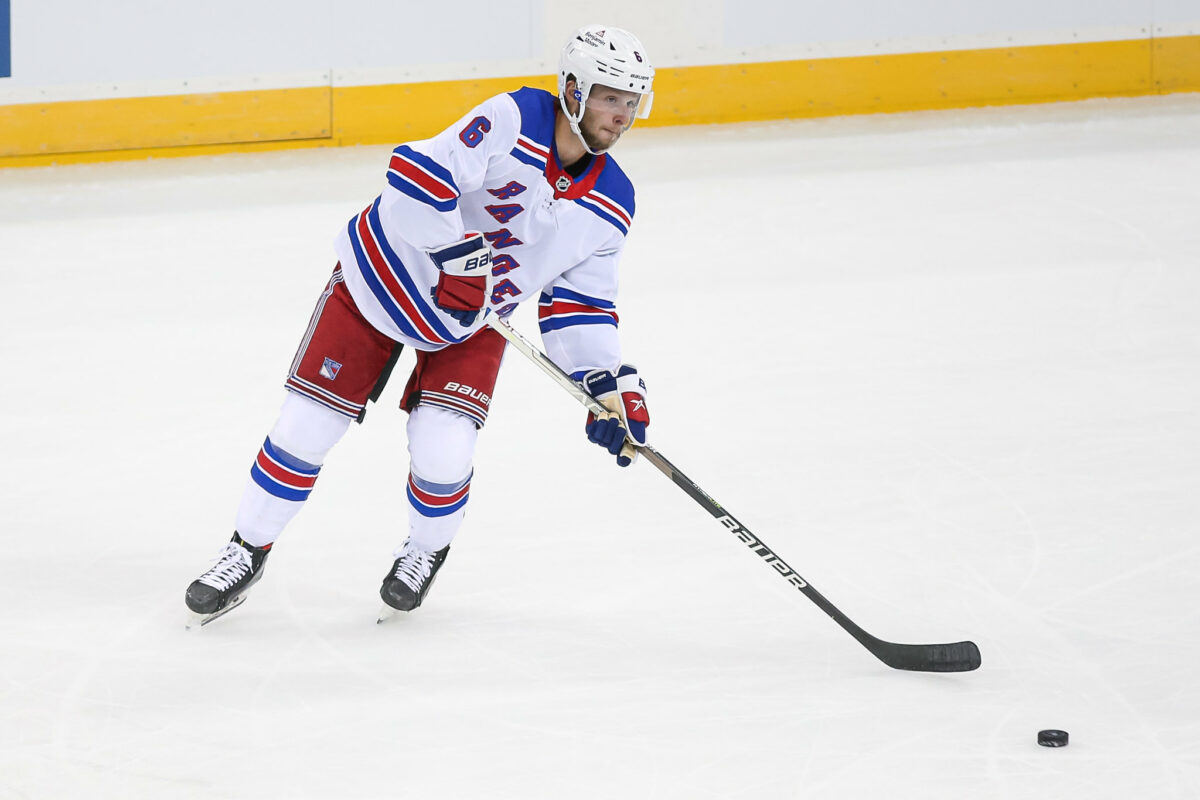After waiting ever-so patiently for an opportunity, then getting that opportunity and seizing it, New York Rangers defenseman Zac Jones finds himself waiting once again.
The 23-year-old blueliner, though, can take heart in the fact that his eye-opening extended run of games that allowed the Rangers to stay afloat amidst injuries should open up his biggest possibility next season.
As the 2023-24 regular season draws to a close, Jones is back to his role as the Blueshirts’ seventh defenseman, a spot he occupied to start the season largely because he could no longer be sent to the minors without passing through waivers. Despite a halting start to his NHL career, the Rangers didn’t want to lose him for nothing, and thus kept him in the blue-line depth role, one that hardly guarantees significant playing time.

Now, the club wouldn’t think of sending Jones down – and probably doesn’t have any interest in trading him, either.
The University of Massachusetts product has played the most consequential hockey of his brief NHL tenure over the past month-plus, drawing into the lineup due to injuries and delivering a 14-game stretch that cemented the idea that he’s a regular-in-waiting. Jones recorded a plus-6 rating in that span, delivering strong defensive work that put to rest the idea that he was little more than a smallish player with speed and power-play skills who would get exposed by big, strong forwards in his own zone.
Jones Has Made the Most of His Sporadic Ice Time
That certainly seemed to be the case over Jones’ first three seasons, during which he looked uncertain and overwhelmed at times in 38 total games. Yet his evolution as a player has been impossible to miss in his career-high 31 contests this season. Jones’ 5-foot-11, 185-pound frame hasn’t been an issue whatsoever, with the 2019 third-round draft pick overcoming his lack of ideal size by being hard on the puck, using his quickness and lateral movement effectively and employing the outstanding instincts that led the Rangers to select him 68th overall nearly five years ago.
Nothing Jones has done this season, however, has been more impressive in the way he’s handled his fickle relationship with ice time. He went a month without playing from mid-December to mid-January, and then did it again from early February to early March. In between, he went in and out of the lineup for shorter stretches, living the life of a depth player after starring in UMass’ run to the NCAA Championship in 2021.
“He was (sitting) out for a good majority of the games, worked his tail off every game, every practice, every day,” coach Peter Laviolette said of Jones last month. “Real positive attitude. The last games that we played him in, prior to him jumping back in the lineup, he was excellent. I think he had a (two)-point night (in Ottawa on Jan. 27), he was plus-4, he played extremely well. He really didn’t deserve to come out of the lineup, but he did. Those are decisions that you have to make sometimes.
“He’s gotten an opportunity to jump back in. He’s waited, he’s been patient, worked hard to get the opportunity and he’s jumped back in and he’s played excellent again.” (From ‘Zac Jones Paying Back Peter Laviolette’s Rangers Loyalty’, New York Post, 3/14/2024)
Jones was a plus-4 in his last three contests, highlighted by a plus-2 effort over 18:34 in a 5-2 loss to the Pittsburgh Penguins on April 1.
Related: Rangers’ Last 3 Games Should Secure Presidents’ Trophy
Jones’ 14-game run in the lineup ended when the Rangers’ rash of blue-line injuries concluded with the return of Erik Gustafsson from a 10-day absence, the veteran having suffered an upper-body injury against the Florida Panthers on March 23. Though Jones’ underlying metrics weren’t exceptional during that stretch, with a 47.9 expected goal share and 68 scoring chances for to 70 against, he posted a 50.2 Corsi for mark. Most importantly, the Blueshirts outscored opponents 9-4 with Jones on at 5-on-5 over those 14 contests.
Unafraid to battle for the puck along the walls and in front of the net, Jones’ rising game has earned Laviolette’s trust. With the Rangers’ regular six defenseman all back after Gustafsson, Ryan Lindgren and Jacob Trouba missed time recently, there’s not a clear path to ice time in the playoffs for Jones, other than remaining ready to step back in when needed – just as he has all season.
That, however, may be besides the point when it comes to Jones’ future outlook. Gustafsson has been a revelation as the left-side third-pair defenseman after signing a one-year, $825,000 bargain-basement contract in the offseason, recording six goals and 24 assists. The 32-year-old, though, will likely receive a more lucrative multi-year offer this summer, something to which the Rangers seem highly unlikely to commit, given the daunting salary-cap challenges they face over the next few seasons.
Paying substantial dollars for a third-pair player doesn’t represent good fiscal policy in the cap era. Filling those spots is generally a study in finding value, and Jones should get every chance to provide it. With an $812,500 cap hit for 2024-25, the final year of his entry-level contract – essentially the same dollar amount as Gustafsson’s this season – Jones’ time to graduate to a consistent lineup spot appears to be just about here.
Jones’ Power-Play Prowess Has Yet to Be Tapped
The Rangers, in fact, have hardly attempted to tap Jones’ full potential to this point. They’ve gotten more than they could have hoped for in 2023-24, with his defensive work engendering confidence from Laviolette that Jones can hold his own in limited minutes and mostly sheltered matchups. The offensive side of Jones, while showing up from time to time, has yet to be put in position to bloom.
Jones came to the Rangers with the reputation of a natural power-play quarterback. Getting a meaningful shot to show them how he could produce in that role, this season or next, represents an extremely tall order. With Adam Fox and Artemi Panarin entrenched at the points for the Blueshirts’ lethal top man-advantage unit – one that tends to eat up most of the time on penalties – there’s usually only table scraps remaining for the second unit, on which Gustafsson mans the point.
Assuming Gustafsson leaves in free agency, Jones could be looking at yet another golden opportunity, this one a chance to get his foot in the door running a power play, even if it’s only going to be for 30 seconds or so each time.

Jones also brings a much-needed element of speed and elite skating from the back end, with the ability to carry the puck quickly out of the defensive zone when needed. He’s learned to use his outstanding east-west quickness to more effectively evade forecheckers this season, another key facet in the emergence of his strong play in the Rangers’ own zone. His growing confidence with the puck in the offensive zone is also evident, as he’s been willing to carry it deep and attack and circle the net without fear of not being able to get back into position.
Like Fox, Jones looks capable of rendering his smaller build irrelevant. That’s no attempt to compare Jones to the 2021 Norris Trophy winner, who’s among the best in the NHL at his position. What it does indicate is the same kind of hockey smarts, adaptability and edge that helped Fox, who measures in at essentially the same height and weight as Jones, become what he is now.
In a wildly successful regular season for the Rangers, Jones’ growth has been among the team’s pleasant surprises. Perhaps more are in store for the playoffs, but if not, the Blueshirts seem certain to find out just how far Jones has come in 2024-25 – this time as an every-game player.